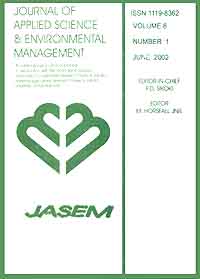
|
Journal of Applied Sciences and Environmental Management
World Bank assisted National Agricultural Research Project (NARP) - University of Port Harcourt
ISSN: 1119-8362
Vol. 11, No. 4, 2007, pp. 33-36
|
 Bioline Code: ja07089
Bioline Code: ja07089
Full paper language: English
Document type: Research Article
Document available free of charge
|
|
|
Journal of Applied Sciences and Environmental Management, Vol. 11, No. 4, 2007, pp. 33-36
| en |
Water Quality Evaluation From Lomé’s Lagoon: Effects on Heavy Metals Contamination on Fishes.
Bawa, L.M.; Djaneye-Boundjou, G.; Boyode, B.P. & Assih, B.T.
Abstract
The relevance of this study shows that in general, water of lake of Lome has a strong alkalinity
(pH raging from 8.8-9.2) and a strong salinity revealed by the high value of the electric conductivity (2800-3200
μs.cm-1). An impressive algae colony is composing the essential suspended matter (60-70 mg.l-1). The water turbidity
was about 80-90 NTU. We also determined that in some places of the lake, the high concentration of nitrogen
compounds appeared to be the major causing pollution since the NTK (total nitrogen) ranged from 20-22 mgN.l-1. In
contrast, the COD (chemical oxygen demand) and the BOD (biochemical oxygen demand) values were low (110
mgO2.l-1 and 40 mgO2.l-1 respectively). In the case of metallic elements, cadmium contents was very low in water,
sediments and fishes. Copper, lead, zinc and mercury concentrations in water were respectively 3.6; 8.0; 7.0 and
14.0μg.l-1. In fishes, the following measured values of the same elements were 5.0; 2.8; 20.2 and 5.5 μg.l-1
respectively.
|
| |
© Copyright 2007 - Journal of Applied Sciences & Environmental Management
|
|
